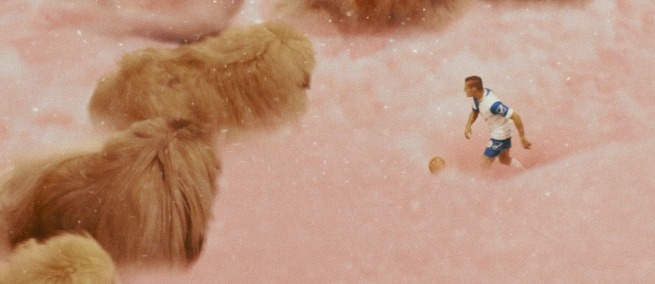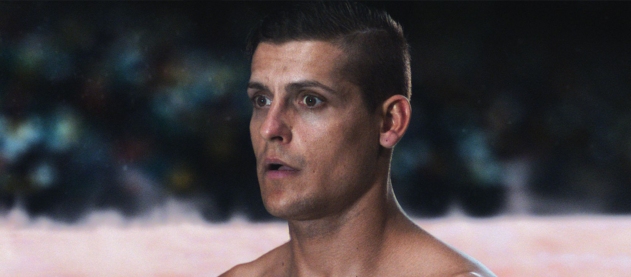
[Editor’s Note: This article is part of “Peer Review,” an ongoing series in which we commission research scientists to write about topics in current film or television. Dr. Heather Berlin is a cognitive neuroscientist and Assistant Clinical Professor of Psychiatry at the Icahn School of Medicine at Mount Sinai. We asked Dr. Berlin to write about the new film DIAMANTINO, directed by Gabriel Abrantes and Daniel Schmidt, which won the Grand Prize at Cannes Critics’ Week and opened the New York Film Festival Projections section. The film premiered in New York on May 24 and is continuing to open at theaters across the country.]
In Gabriel Abrantes and Daniel Schmidt’s satirical thriller DIAMANTINO, the film’s eponymous protagonist is an Adonis-like soccer star, beautiful and innocent, and endowed with an almost supernatural talent for the game. But how do you cinematically represent athletic genius, besides simply showing a series of brilliantly executed moves? The film hits on a novel and surreal visual device. When Diamantino (played by Carloto Cotta) is “in the zone” during a game, the soccer field (or “football pitch” for those across the pond) transforms into a pinkish cloudscape populated entirely by enormous frolicking fluffy puppies. How does our star player continue to navigate the rapid and complex strategic battlefield, avoid opposing teams’ defenders, and remain aware of his teammates’ positions and their openness for a winning pass? We aren’t told. Instead, the fluffy puppy world shows us what it subjectively feels like, the psychology of pure creativity, when the world and its cares fall away and it’s as if we are guided by a divine muse. There is no time, no place, no self, only flow. Who wouldn’t want to enter that state?
Neuroscientists have found that this transcendent psychological state cuts across multiple domains of human activity and is associated with a distinct pattern of activation in the brain. We can’t put soccer players in fMRI scanners while they play, but studies of jazz improvisersand freestyle rappers can serve as a proxy. During the “flow state” associated with spontaneous creativity, a part of the brain called the dorsolateral prefrontal cortex, or DLPFC, decreases in activation. This part of the brain is involved in our sense of self and time, and our ability to monitor social context. It is active when we ruminate or worry, and it filters our thoughts and behaviors to make sure they conform with societal norms. The DLPFC also activates when we suppress unwanted memories, thoughts, and emotions. It has been called the “inner critic,” and when it gets damaged, people tend to get into all kinds of trouble. But, turning it down temporarily and purposely can lead to moments of pure ecstasy and brilliance.
Simultaneously, the medial prefrontal cortex, or MPFC, increases activation during flow states, and we know this part of the brain is correlated with the internal generation of ideas. This can lead to spontaneous connections (for instance novel soccer moves), but with the DLPFC turned down you also get normally-suppressed unconscious thoughts bubbling up. This is why freestyle rappers often say they surprise themselves with their improvised lyrics, since the unconscious is populated by vast stores of information we can’t normally access consciously. However, in the film, Diamantino lives a sheltered life of childlike-innocence, oblivious to everything but the world of soccer. So his shallow subconscious is represented as puppies and clouds and nothing else, making it easy for him to enter into athletic flow statesand score seemingly-impossible goals.
Of course, blissful ignorance in films (as in life) tends not to last, and in DIAMANTINO the protagonist’s life and mind suffers a series of intrusions, first by the European refugee crisis and then by a cabal of right wing Euro-skeptic nationalists intent on building a wall and ejecting asylum-seekers in order to “Make Portugal Great Again”–MPGA! Thoughts of refugees derail his flow state and cause him to miss the winning shot in the World Cup final, and we can almost see his DLPFC revving up when it’s supposed to be quiet.
His soccer career in ruins, Diamantino must now embark on a journey of redemption and discovery in which he adopts a refugee, falls in love, and falls prey to the greedy manipulations of family members and the devious attempts of fascist geneticists to clone his ‘genius.' It’s a wild ride that I won't spoil for readers who haven't seen the film yet, but suffice to say it leads him back to a place where he can once again access hisdreamlike flow state, although now it is populated by images of love and sexuality instead of ridiculous frolicking fluffy puppies.Innocence lost, experience found.
There are layers upon layers in DIAMANTINO, which satirizes both contemporary national populist politics and the darker sides of human nature and scientific inquiry. Like a good David Lynch film, it could (and perhaps will) be the subject of several doctoral dissertations. However, singling out the elements that relate to flow state and athletic genius, Diamantino’s arc of redemption is important. In the beginning, the film comes close to making an argument that creativity and ignorance go hand-in-hand.

Don’t let too much knowledge about the world intrude on your pristine psyche or you might miss the winning shot! But as the protagonist leaves the bubble of his sheltered life, like Adam and Eve or like Herman Hesse’s Siddhartha, he gains a richer form of knowledge that can engage with the world’s challenges and still interact with flow state. This is good news for the rest of us, who want to both understand the world and enjoy moments of pure creativity without unwanted thoughts intruding. That’s not something we have to clone from a rare genius. It’s in us all to find, hidden among the pink clouds of brain activation.
cover image: scene from DIAMANTINO, courtesy Kino Lorber
TOPICS